Evolving Workforces
Law Firm Benchmarking Survey Results 2024
Law Firm Practice Group & Americas Consulting
March 5, 2024 7 Minute Read

Executive Summary
Looking for a PDF of this content?
In 2023, law firms focused on setting hybrid policies, evaluating real estate priorities and future opportunities. The legal workplace is undergoing transformation, as the pandemic accelerated trends that were already on the rise. Hybrid work, real estate costs and talent pressures are key evolving factors. The future legal work environment needs to balance flexibility, privacy, collaboration and socialization to support productivity and relationships. It should be a place where professionals want to spend their time.

Key Findings
- The legal industry has been at the forefront of setting office attendance policies requiring in-office work. However, space utilization remains lower than preferred.
- Strengthening culture and professional development are driving leaders to prefer higher office attendance.
- Doing more with less is the leading real estate strategy for the legal industry in the post-pandemic era.
Watch Now: Insights from the Authors
A panel of CBRE experts discusses the implications for the legal industry of hybrid work's impact on office attendance patterns, evolving real estate and workplace strategies, and the outlook for the year ahead. Watch the video:
Methodology
CBRE conducted an annual benchmarking survey in October 2023 to analyze real estate priorities among law firm leaders. The responses represent a diverse group of law firms in terms of firm size, portfolio size and geographical location.
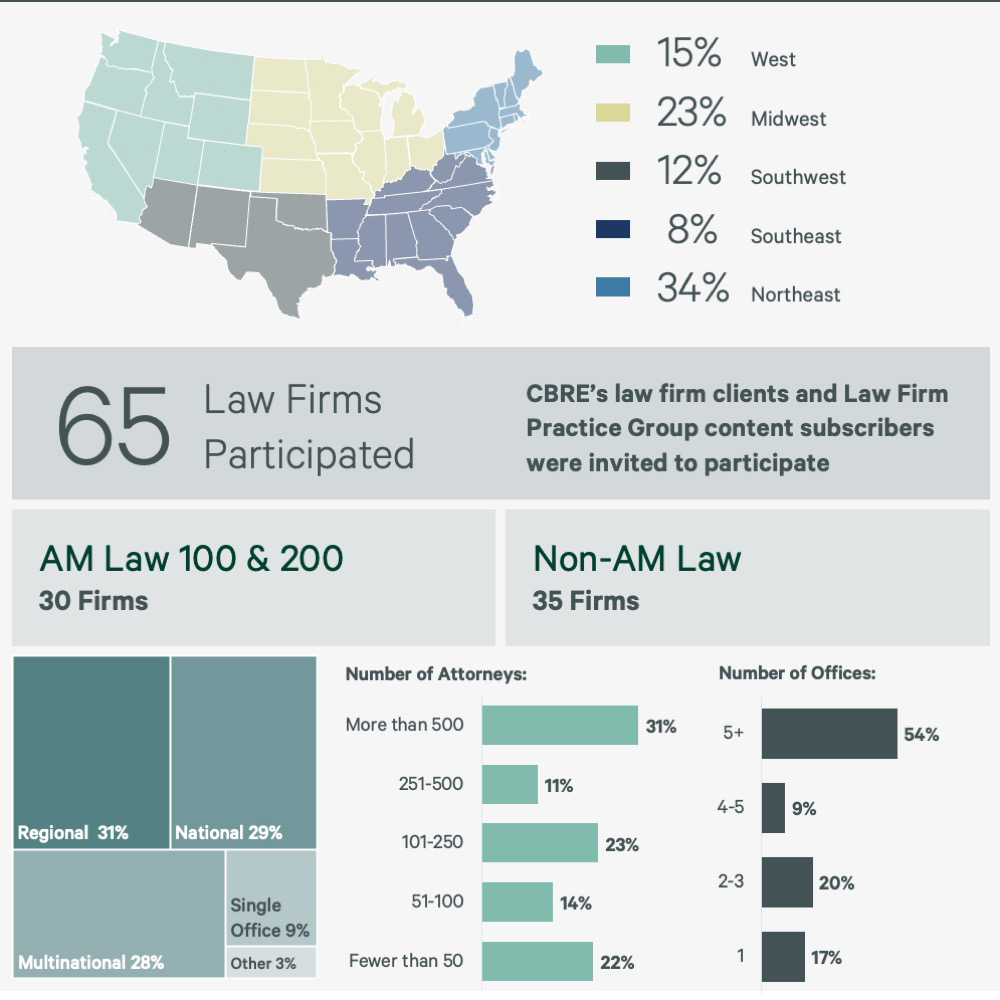
Office Attendance Policy
According to survey participants and CBRE’s research, average legal office attendance exceeded other industries in 2023. But law firm leaders would prefer to see even more in-office working in 2024.
Almost All Firms Have an Established Hybrid Work Policy
However, only 1/3 have a universal, firm-wide approach. In many cases, office attendance policies provide attorneys with more flexibility to decide when or on what days to come in, while professionals and staff follow a routine of preselected days.
Often, the requirement for professionals and staff to follow a defined schedule is due to the nature of the support they provide. Teams like Facilities, IT and Catering are required in the office close to 100% of the time for operational support. Teams like paralegals, secretaries and other non-legal professionals are also required to be in the office more often than not to ensure time-sensitive matters are addressed quickly and seamlessly. The range depends on the firm and can be anywhere from 3-5 days.
Survey Question: My firm has an established hybrid working schedule/policy.
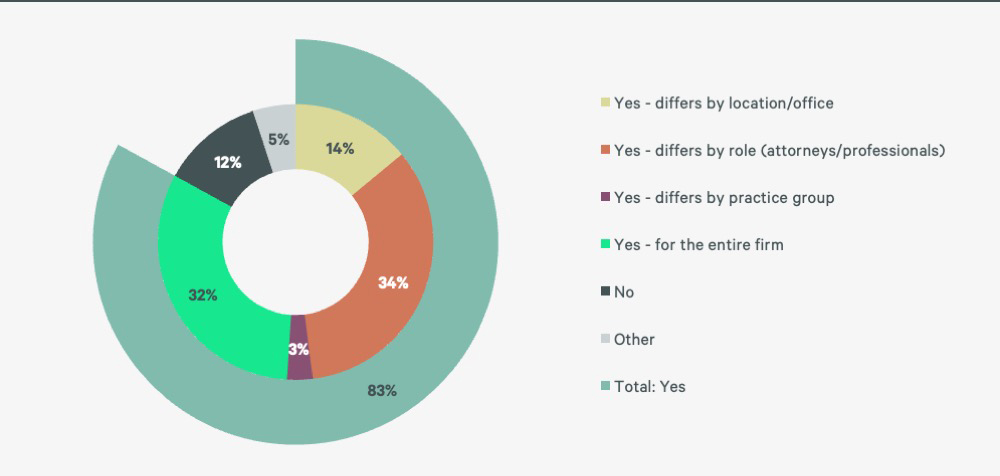
Survey Question: Our firm's hybrid work policy requires colleagues to...
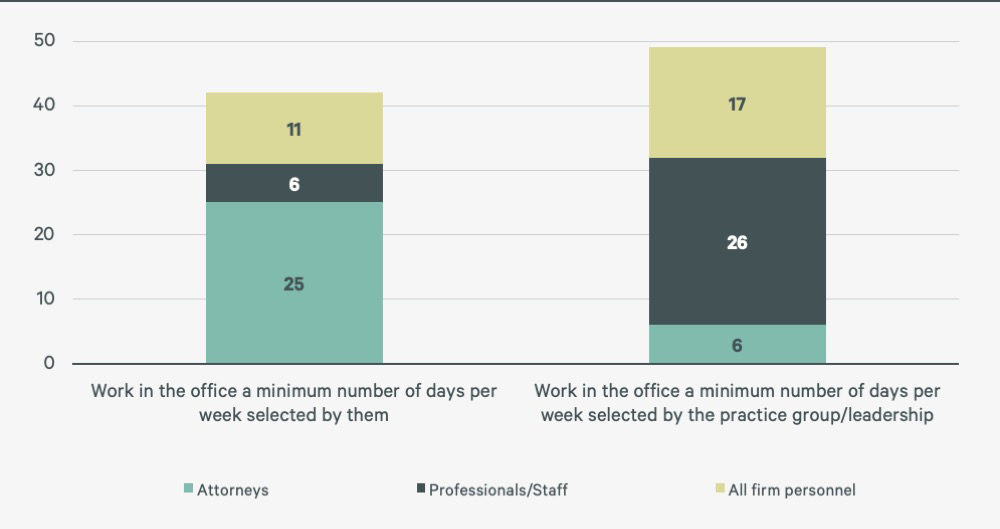
Most Law Firm Leaders Report Office Utilization Exceeding 50%
Hybrid work policy also plays an important role, as there is a positive correlation between policy and office utilization. Survey responses confirm that firms with more than 50% office attendance mostly have a “primarily in-office” policy. Firms with more flexible attendance policies have less in-office work.
Despite some firms reporting more than 50% space utilization, office attendance can be widely different depending on day of the week and time of day. Overall, law firm leaders and those partners, associates and professionals coming into the office are looking for higher attendance going forward.
Survey Question: Thinking about the last few months, what's the office utilization at your firm?
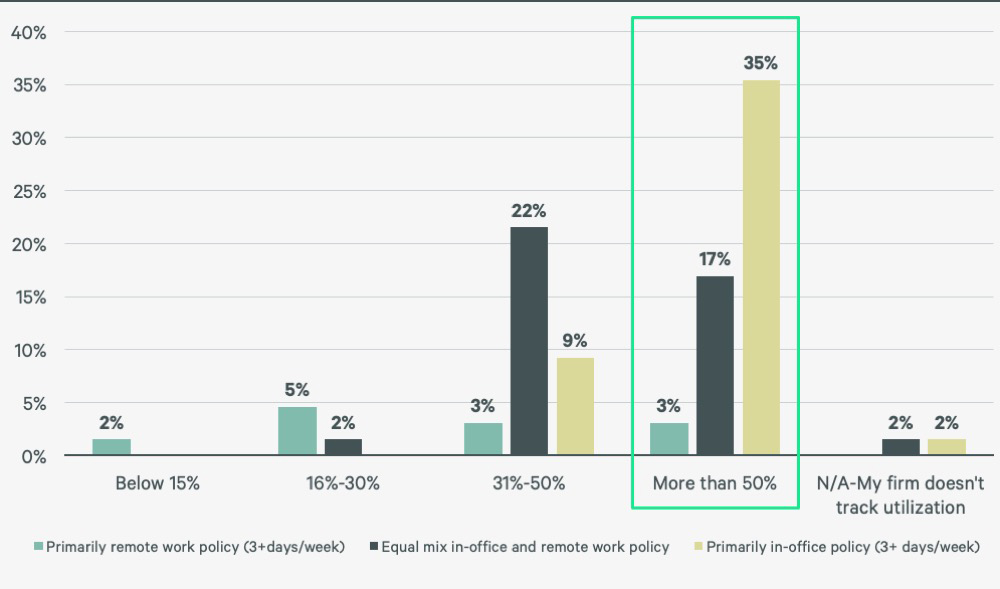
In the Legal Sector, the Most Common Hybrid Work Policy Requires Three or More Days Per Week in the Office
Only 11% of firms do not support hybrid working now or in the future. A majority believe that the hybrid approach is here to stay.
The American Lawyer’s AM Law 100 & 200 firms lean toward flexible solutions balancing remote and in-office work. Non-AM Law firms set policies expecting more in-office work from their employees.
Top methods for encouraging time in office include:
- Increased or improved events and social programming
- Policy communication
- Increased or improved food & beverage amenities
- Partner role modeling of behavior
Survey Question: What is your firm's policy regarding hybrid working? Please indicate where most attorneys/professionals fall.
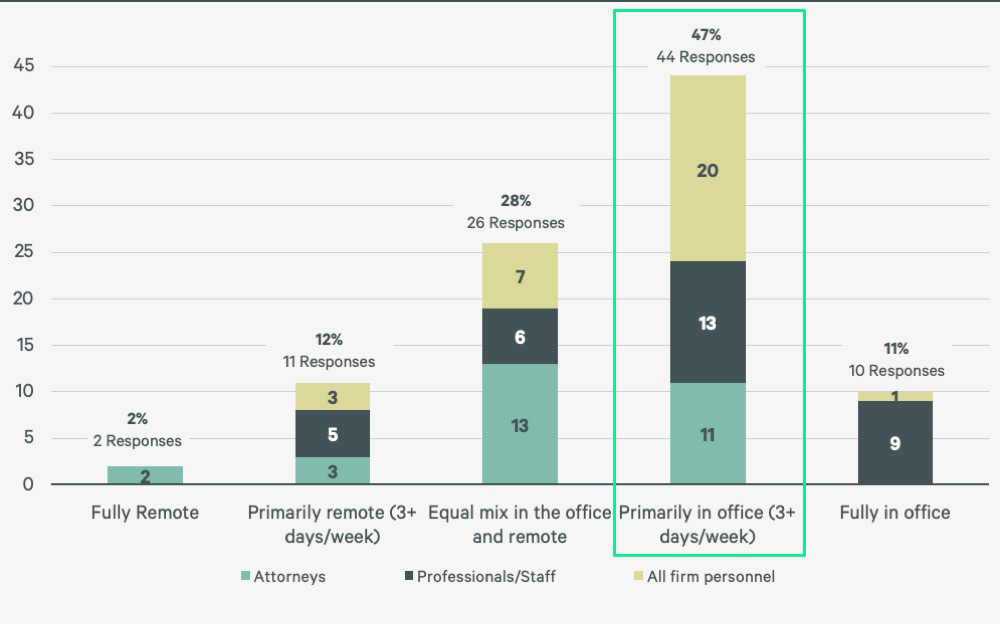
Effectiveness in Managing Hybrid Teams Does Not Equate to Satisfaction With Today’s Attendance Metrics
AM Law 100 & 200 firms report higher effectiveness in managing hybrid teams. Despite this, all firms would prefer more in-office working in the future. More than 70% of law firm leaders feel that their teams are managed effectively in a hybrid format. Leaders cite the importance of being in the office for social and professional opportunities.
Law firms, like other corporate occupiers, must continue to work on aligning the anticipated benefit of the office with the actual employee experience, and building a workplace that supports that value proposition. Attorneys and staff want to know “what’s in it for me,” considering billable and personal time lost to commuting, and the prevalence of virtual meetings being held in the office. As most leaders would prefer more in-office working, it’s important to focus on the “why” behind it.
Survey Question: How effectively do you feel your firm is able to manage hybrid teams?
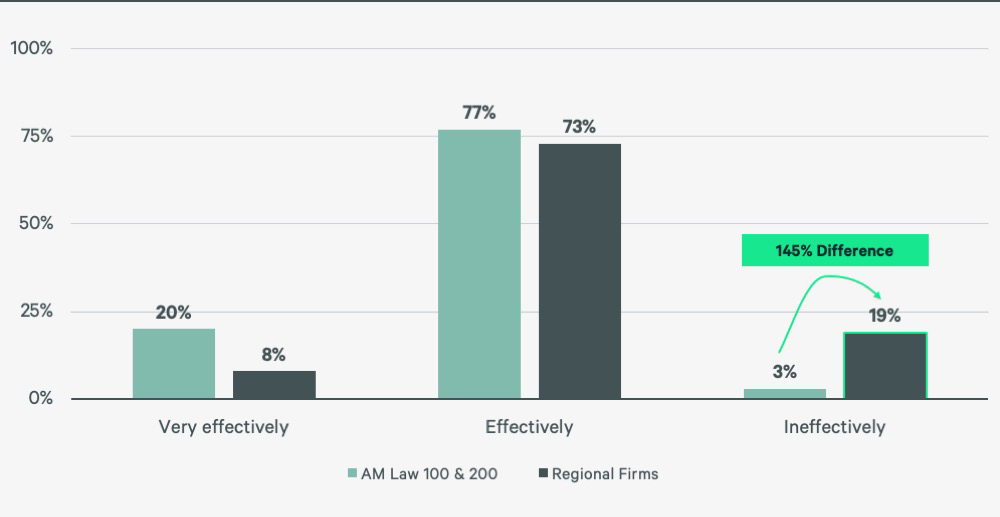
Survey Question: How does the firm feel about current office attendance?
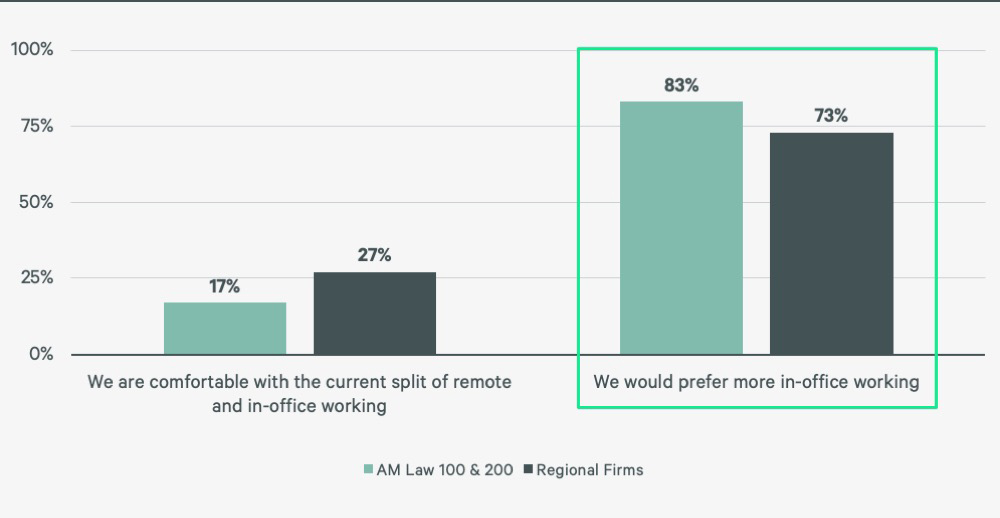
Real Estate Priorities
According to survey participants, talent attraction and retention is the most important driver of real estate decisions.
Talent Attraction and Retention is a Top Priority
Most firms recognize the importance of the overall workplace experience, providing employees with spaces, services and experiences that best support their needs. Many firms are still focusing on setting a workplace strategy to adjust pre-pandemic workplaces to post-pandemic, hybrid work styles. While cost savings are not among the top priorities for law firm executives, they still remain an important consideration.
The analysis also reveals differences in real estate priorities between AM Law 100 & 200 and non-AM Law firms. AM Law 100 & 200 firms are more concerned with portfolio optimization compared with regional and boutique firms, which typically have smaller portfolios with fewer opportunities to optimize. Supporting ESG goals and improving space data accuracy are not yet prime considerations for law firm leaders. However, these two topics are expected to receive increased focus in the coming years, reflecting their significance for other industries.
Survey Question: What are your firm’s real estate priorities?
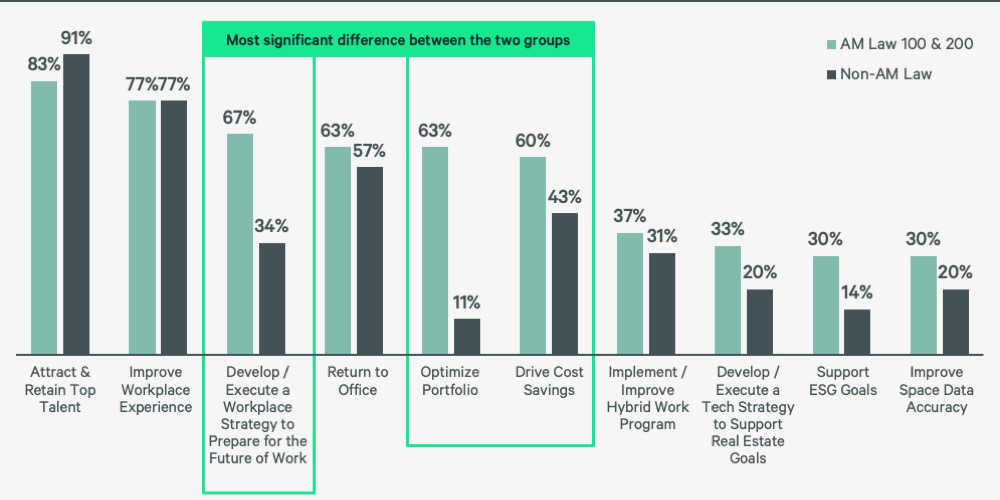
Culture and Professional Development Are the Leading Factors That Drive a Preference Toward Higher Office Attendance
The majority of law firm leaders agree that remote work offers fewer opportunities to network and socialize, as well as fewer professional opportunities compared to showing up regularly at the office. Additionally, the majority of law firm leaders agree that through the height of remote work their culture held steady, neither strengthening or weakening. National and regional firms have experienced the largest negative impact. Multinational firms have been impacted the least, most likely because there were already tools and practices in place to manage distributed teams prior to the pandemic.
Survey Question: How do you feel professional development and social opportunities (informal networking with colleagues) are impacted when working remotely compared to working in your firm’s office?
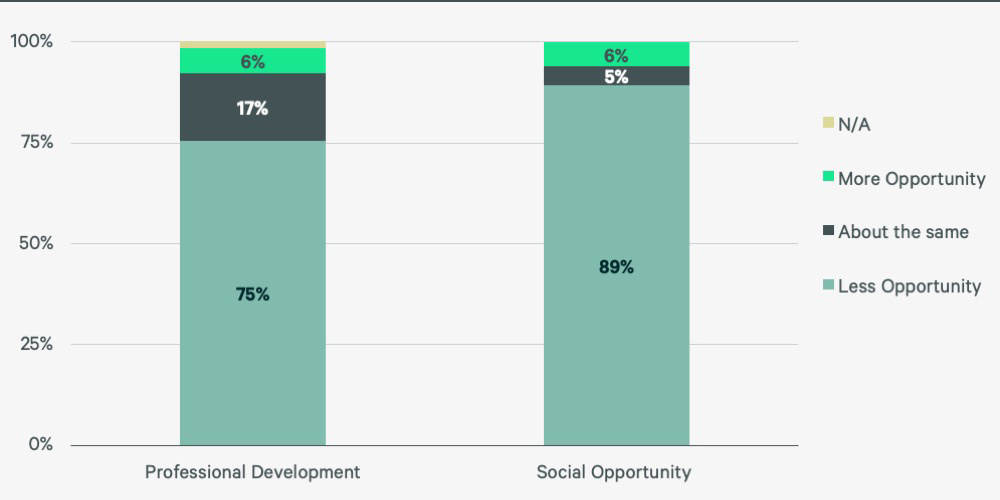
Survey Question: How has firm culture been impacted by the pandemic?
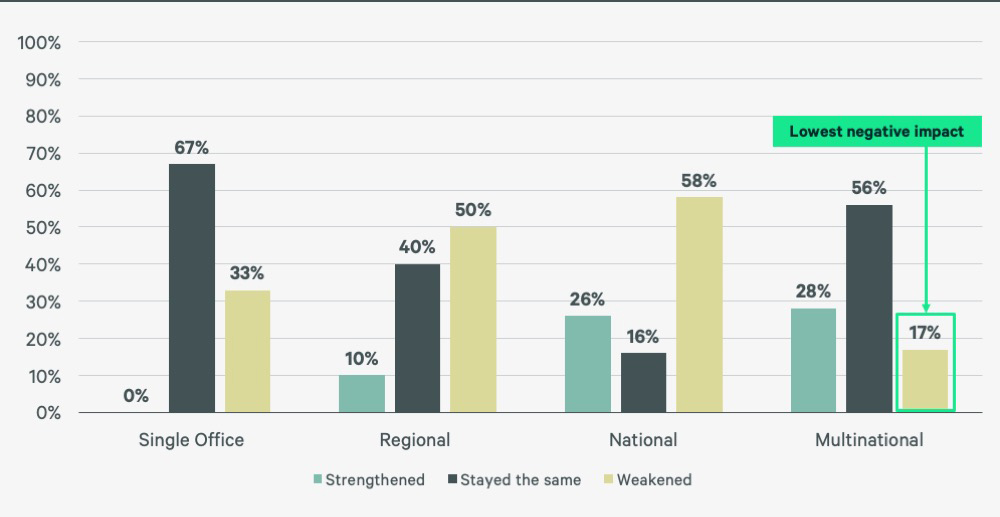
The Tangible Benefits of the Office Are Less Important to Firms Than the Intangibles
Many attorneys and professionals have home offices that support focus, comfort and access to technology comparable (or preferable) to what the office provides. The intangibles, however, such as mentorship, new employee onboarding, developing relationships and collaborating on substantive work are unequivocally better supported in the office.
During a new office fit-out, tangible office elements tend to receive more attention than the intangibles. The key is to determine which tangible elements—like technology hardware or space types—will best support the intangible benefits: a collaborative, vibrant workplace experience.
Survey Question: In considering professional development, how important is it to be in the office for the following needs and opportunities for colleagues at your firm? The graph below groups the important and very important responses.
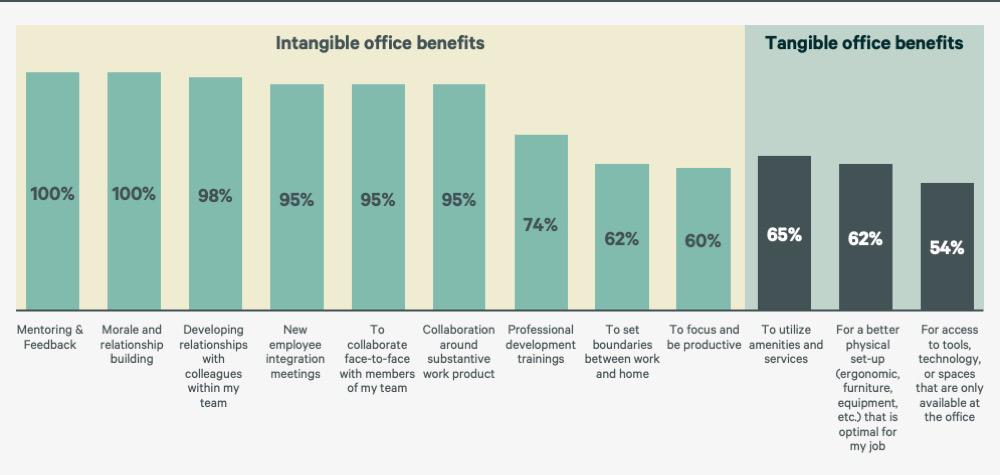
Footprint Sizing
Only 17% of law firms plan to expand their real estate portfolio significantly, and the majority plan to accommodate growth within a similar footprint.
Law Firm Footprint Expectations
Most law firms will maintain or moderately reduce their footprint over the next three years. Only 14% of law firms are expecting significant changes in their real estate footprint. Only a small fraction are considering a >30% increase or reduction in their footprint.
Despite the common theme of footprints generally remaining the same, some nuances exist depending on headcount growth and efficiency/flexibility of firms’ current workplace design. AM Law 100 & 200 firms expect more reduction and less growth in space compared to non-AM Law firms.
Survey Question: Which of the following best describes your expectations regarding your firm's office footprint over the next three years?

Progressive Planning to Adapt Spaces to Hybrid Work
Firms are adopting various space-planning strategies to make offices more adaptable to hybrid work. Universal office size is the number one solution to increase space flexibility, followed by desk sharing for both attorneys and staff, and smaller offices and/or workstations. Almost all firms report meeting room AV updates to support hybrid work, reduced travel and ubiquitous mixed-presence meetings.
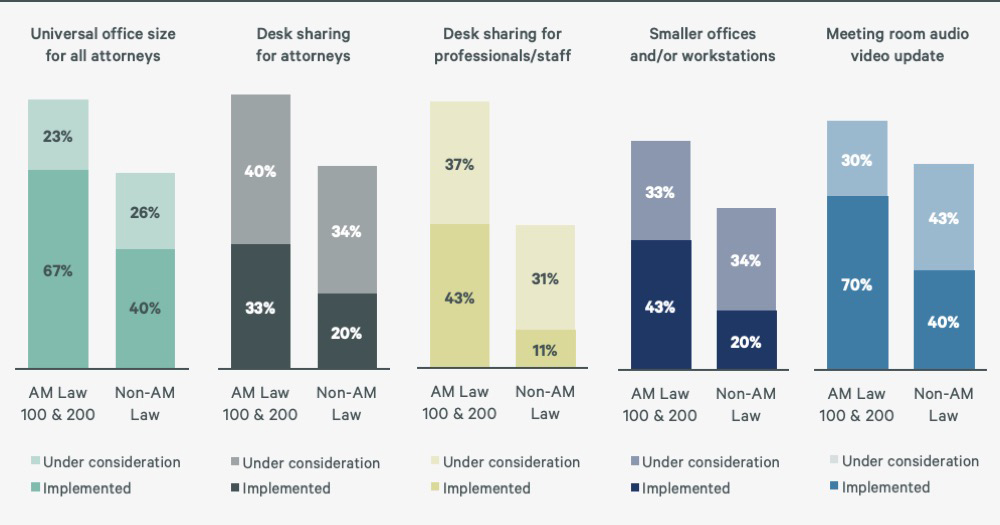
Optimize by Modifying Utilization of the Existing Space
Most law firms surveyed are finding ways to do more with less. Almost all firms are considering multiple strategies to tackle the topic of space optimization, and subletting extra space isn’t the top choice given the current economic climate and demand for subleasing offerings.
Space sharing, accommodating headcount growth in existing portfolios, and repurposing space without renovation are all strategies law firms are implementing to optimize their portfolio without significant investment.
Survey Question: Which of these strategies is your firm using to optimize the real estate portfolio?
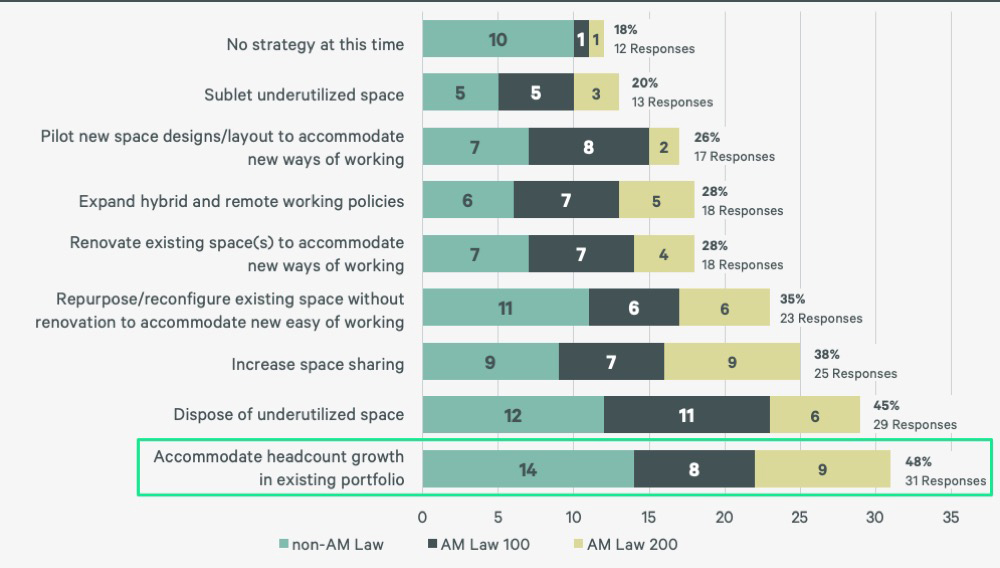
More Efficient Space Planning and Solutions
CBRE tracked pre-pandemic benchmarking data (2017–2020), and the average RSF at that time remained high, at 925 sq. ft./attorney. Most recently, there has been an 18% decrease compared to the pre-pandemic average. Efficiency is expected to increase even more as law firms consider more progressive solutions, like space sharing.
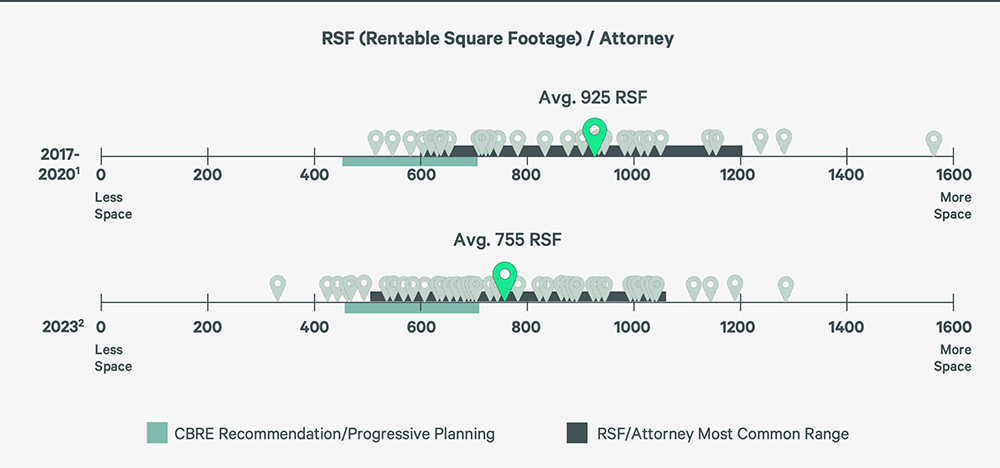
2 Benchmarks collected as a part of the 2023 CBRE LFPG Benchmarking Survey.
Source: CBRE Americas Consulting and Law Firm Practice Group, 2024.
The Next Big Thing
CBRE Americas Consulting predicts that as a new generation of attorneys moves into leadership roles, they will consider more progressive solutions, challenging the status quo.
Five Law Firm Trends to Watch in 2024
-
Purposeful Office Presence
To address the importance of intangible factors and cultural concerns, firms will invest resources into creating intentional mentorship programs, providing leadership access, fostering professional relationships and promoting development. This approach prioritizes engagement rather than expecting these activities to occur naturally. -
Strict Policy or Gentle Nudge?
The approach to hybrid policy may change depending on the current strength of the talent market and the preferences of firm leadership, resulting in a shift of power from employee to employer.
-
Smart Occupancy Tools
Firms using a centralized real estate strategy will find it easier to justify portfolio optimization through increased investment in occupancy management technology.
-
New Experiences to Consider
Law firms are seeing more interest in hybrid work solutions and space efficiency. Younger generations, including millennials, are bringing fresh perspectives to leadership positions and are looking to challenge the status quo to create cost savings and modern office designs.
-
Ready, Set…Go!
Law firms are actively seeking new office spaces, preparing for long-term changes, and updating their pre-pandemic space to a post-pandemic reality. Office space is a top priority for law firms when it comes to brand and business development as they strive to attract the best talent.

Related Services
- Industries
Law Firms
Develop real estate and business strategies for your law firm using our comprehensive, proprietary market research and decades of experience advising ...
- Transform Business Outcomes
Consulting
Gain comprehensive guidance on insightful, executable real estate strategies for both investors and occupiers.
- Transform Business Outcomes
Real Estate Outsourcing Services
Guide transformational outcomes to create tangible value across your portfolio.
Related Insights
-
Brief | Evolving Workforces
Boosting Office Attendance: Selling & Delivering Workplace Value to Employees
December 5, 2023

Many companies and their employees remain out of sync on the amount of time workers should be in the office, according to a CBRE and CoreNet Global survey of 400 corporate real estate professionals.
Contacts
Emily Botello
Managing Director, Americas Consulting

Sarah Gibbons-Scheets
Managing Director, Americas Consulting




